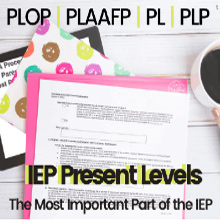One of the most important sections of your child’s Individualized Education Plan (IEP) is the section called “Present Levels of Academic Achievement and Functional Performance” often variously referred to as PLAAFP, PLEP, PLOP, PLP or PL. The present levels section of your child’s IEP delineates how your child is doing in both academics and functional performance.
What the IDEA say about Present Levels of Performance
Let’s look at what the Individuals with Disabilities Education Act (IDEA) says about PLOP:
[IEPs must include] a statement of the child’s present levels of academic achievement and functional performance, including:- (i) How the child’s disability affects the child’s involvement and progress in the general education curriculum;
- (ii) For preschool children, as appropriate, how the disability affects the child’s participation in appropriate activities;
- (iii) For children with disabilities who take alternative assessments aligned to alternate academic achievement standards, a description of benchmarks or short-term objectives. 34 C.F.R. 300.320 (a)(1)
Present Levels and IEP Goals & Objectives
Your child’s present levels of performance should describe how your child is doing in school. Present levels should identify the areas of strengths and weaknesses of your child. Because present levels of performance are the foundation of your child’s IEP, you should make sure that your child’s school team and you write clear and detailed present levels of performance to more fully identify and inform your child’s IEP goals and objectives. Special education and related services (such as speech, occupational therapy, and counseling for example) are all based on your child’s present levels of performance.
Preset Levels Serve as the Bridge Between Evaluations and IEP Services
All present levels of performance within your child’s IEP serve as the bridge between the results of evaluations and the goals and objectives contained within your child’s IEP. Present levels should be clearly written in such a way so as to enable the monitoring of your child’s progress.
What To Include In Your Child’s Present Levels of Performance Statements
Your child’s present levels statements should include the following:
- The sources from which all present level of performance have been determined (i.e., evaluations, assessments, grades, progress reports, data collection).
- How your child is currently functioning to provide an accurate description of your child’s current skills, knowledge and/or behaviors for the IEP team to address in goals and objectives.
- The challenges your child is facing that impact or interfere with your child’s accessing his or her education.
- Current specific, measurable, and objective baseline information and data for each area of need based on your child’s disability (academic, cognitive, reading, writing, math, speech, physical, behavioral, social, emotional).
- Present areas of strength of your child.
Present Levels & IEP Meetings
All IEP meetings should start with a discussion about your child’s present levels of performance. If you, as the parent, disagree with your school team’s presentation of your child’s present levels, you must ensure that your viewpoint is included in the IEP as well.
Forte Law Group Is Here to Help
If any point you and your school team disagree with your child’s present levels of performance, it may be time to consider speaking with an experienced special education attorney to analyze your child’s purported present levels of performance in order to determine your child’s right to special education.



